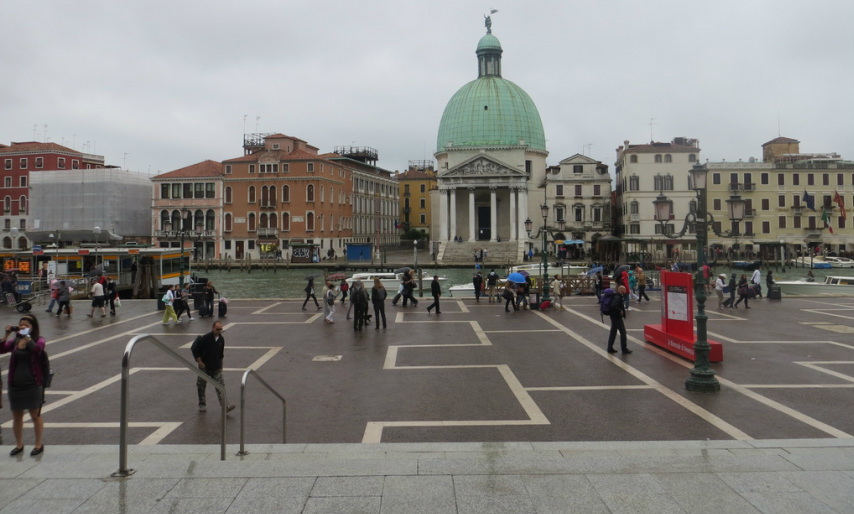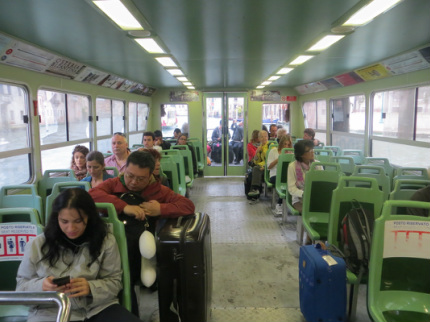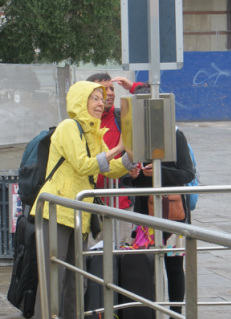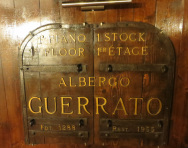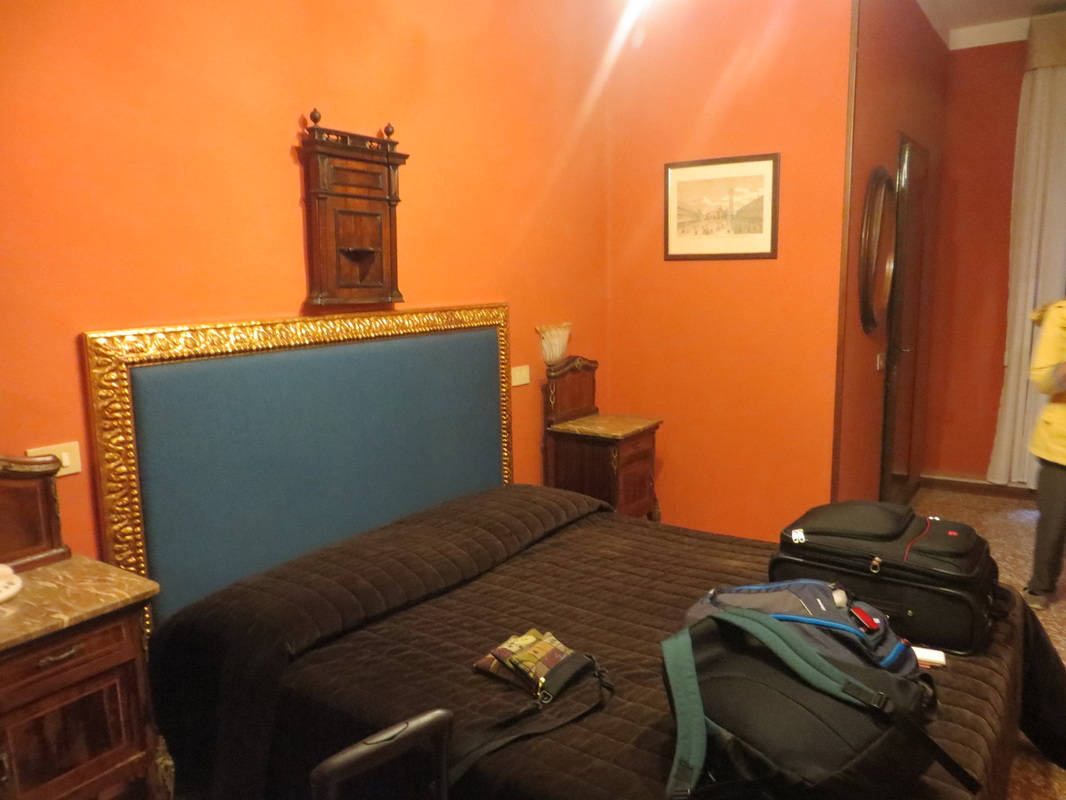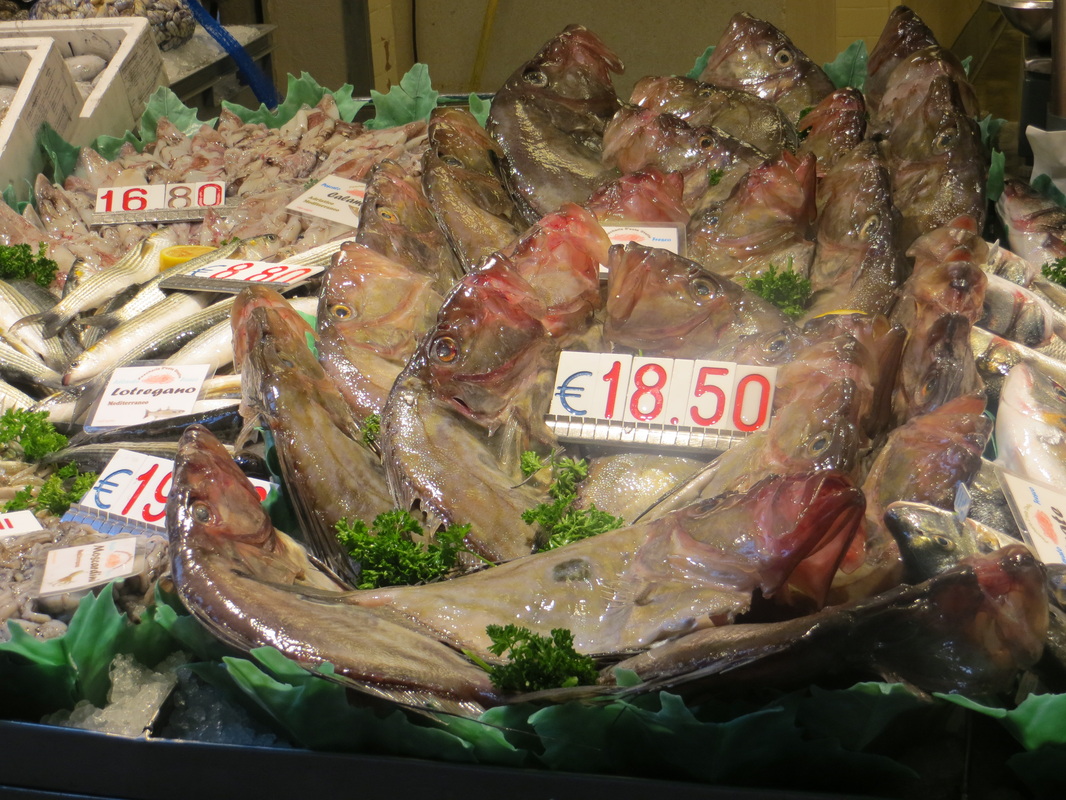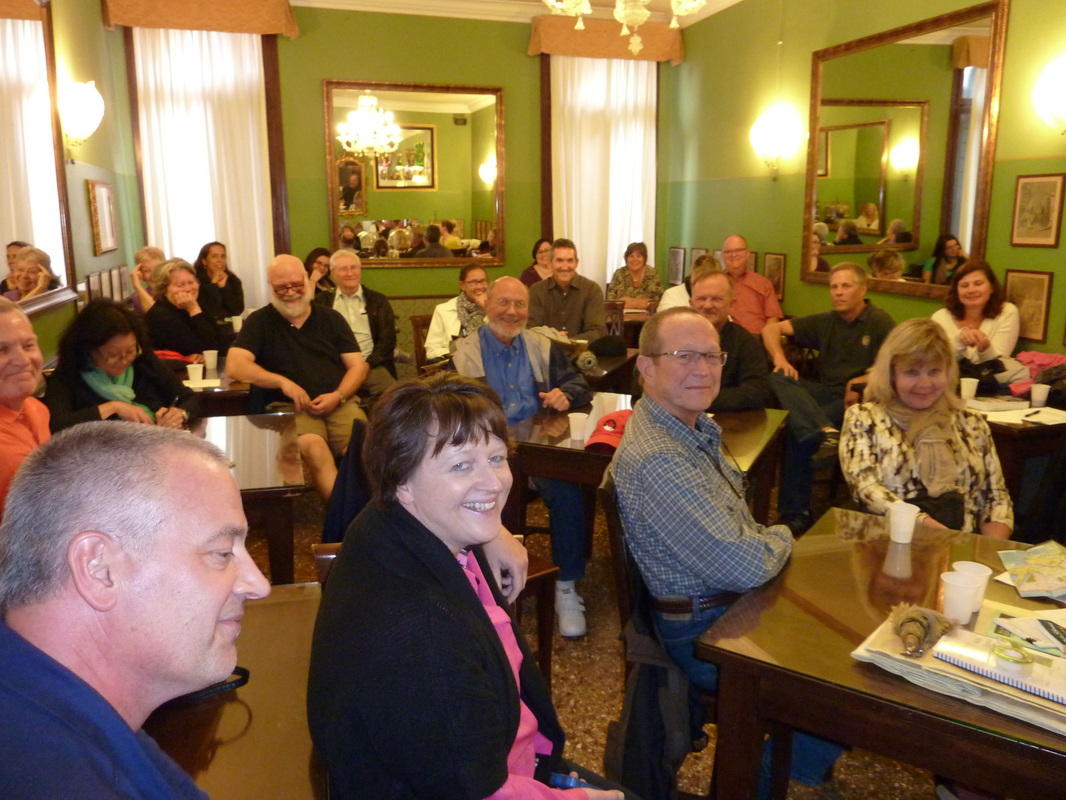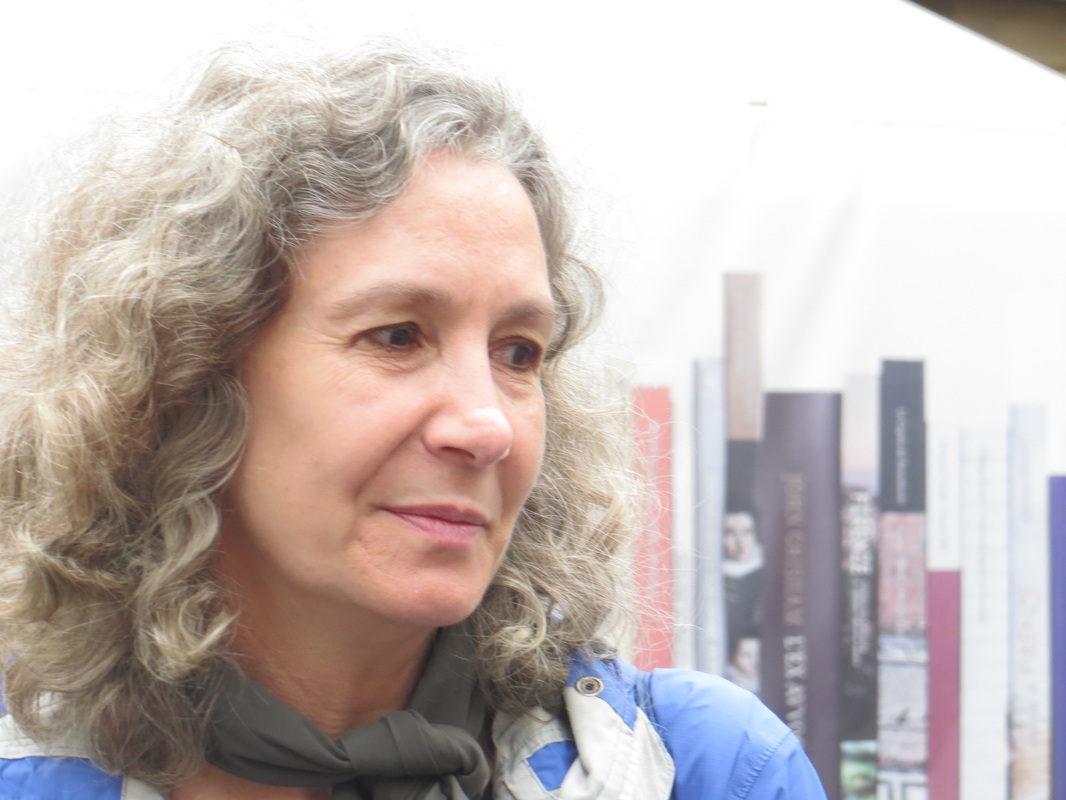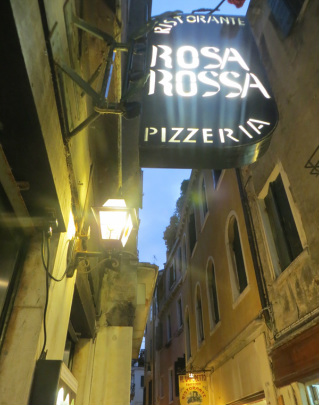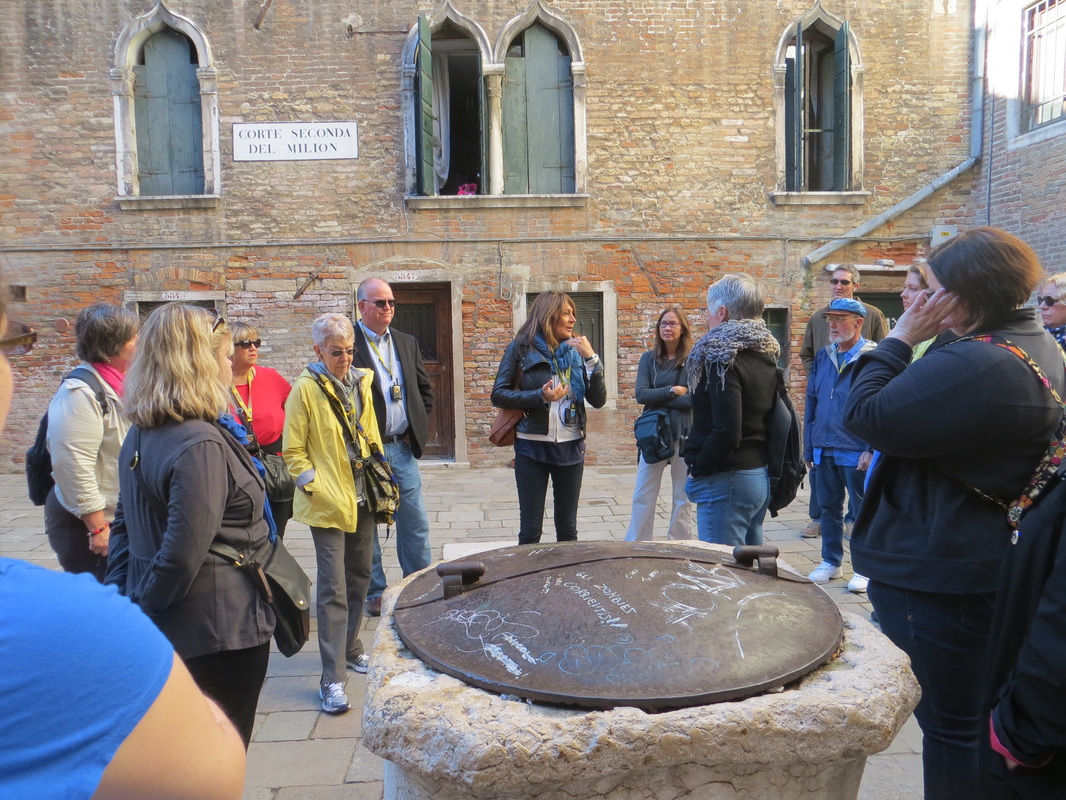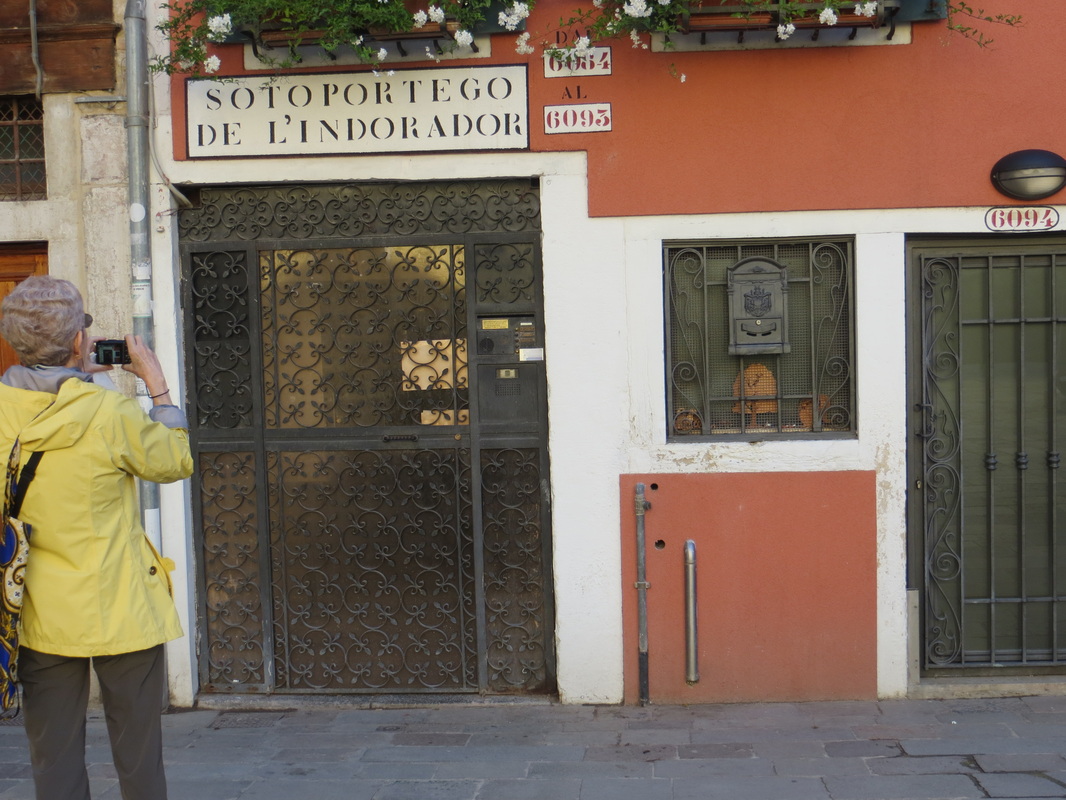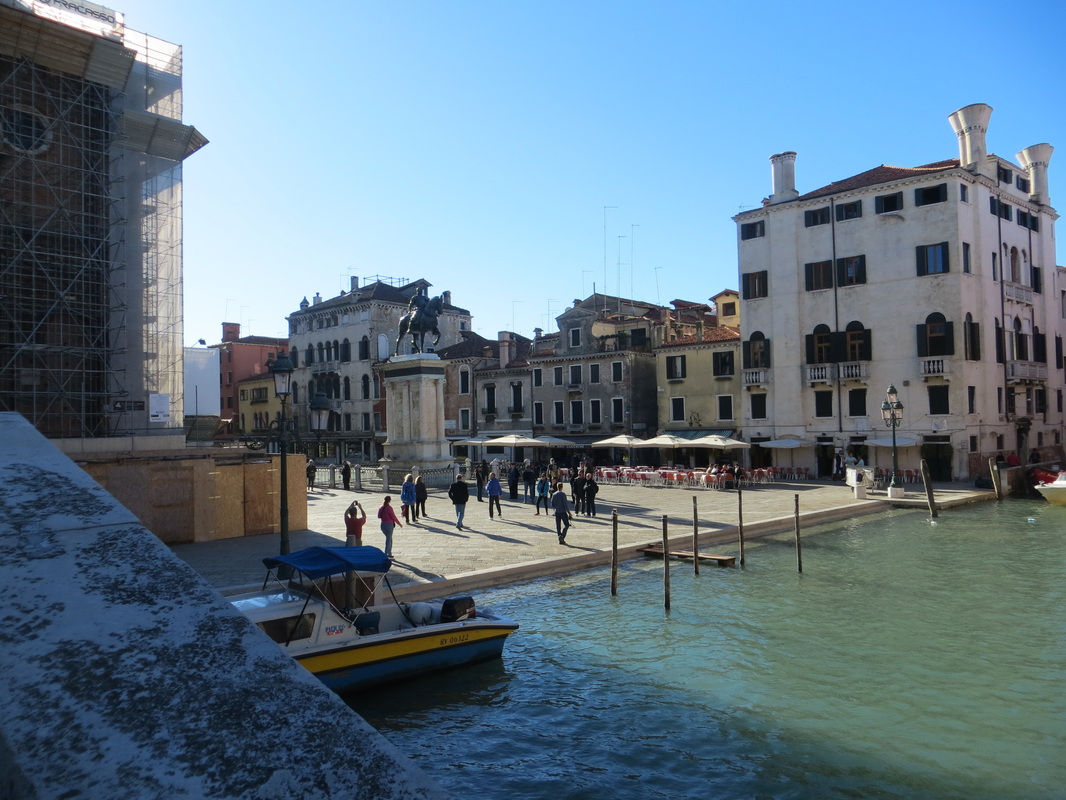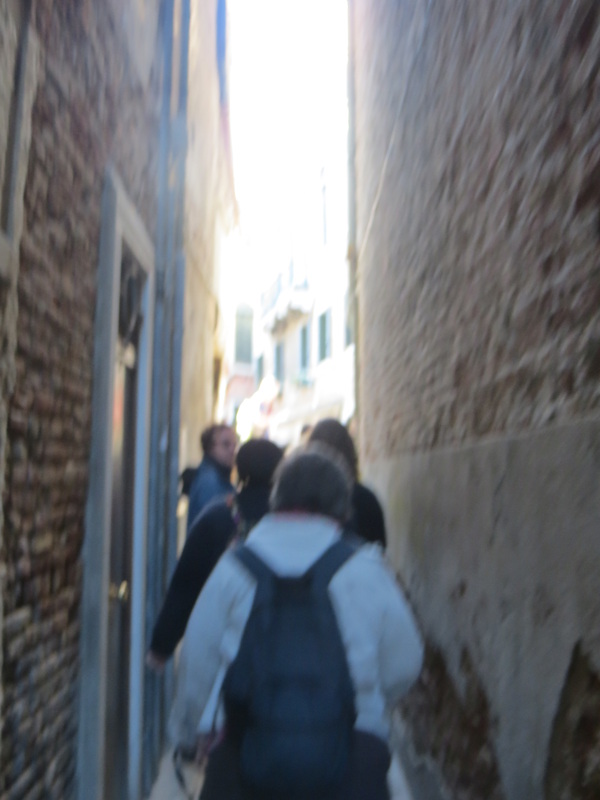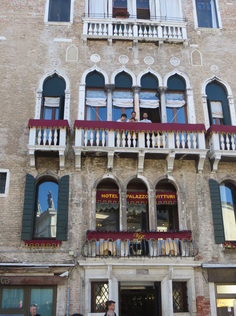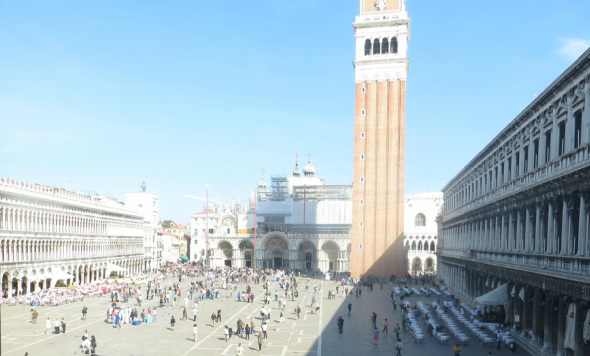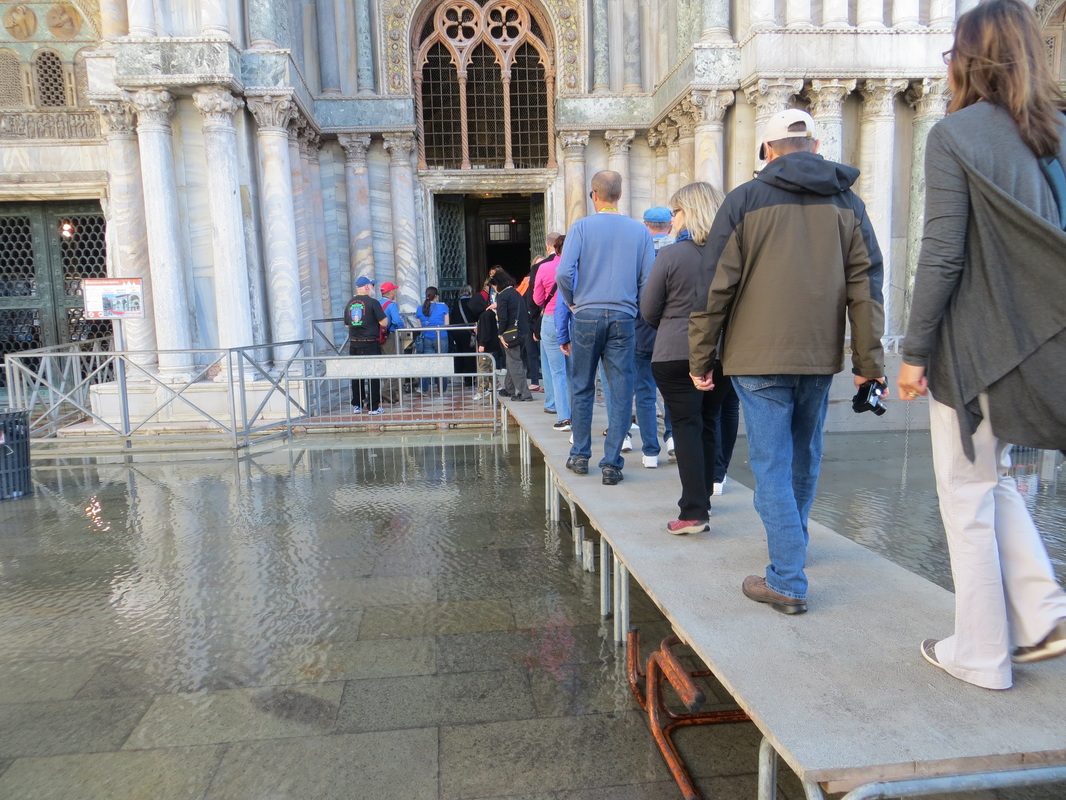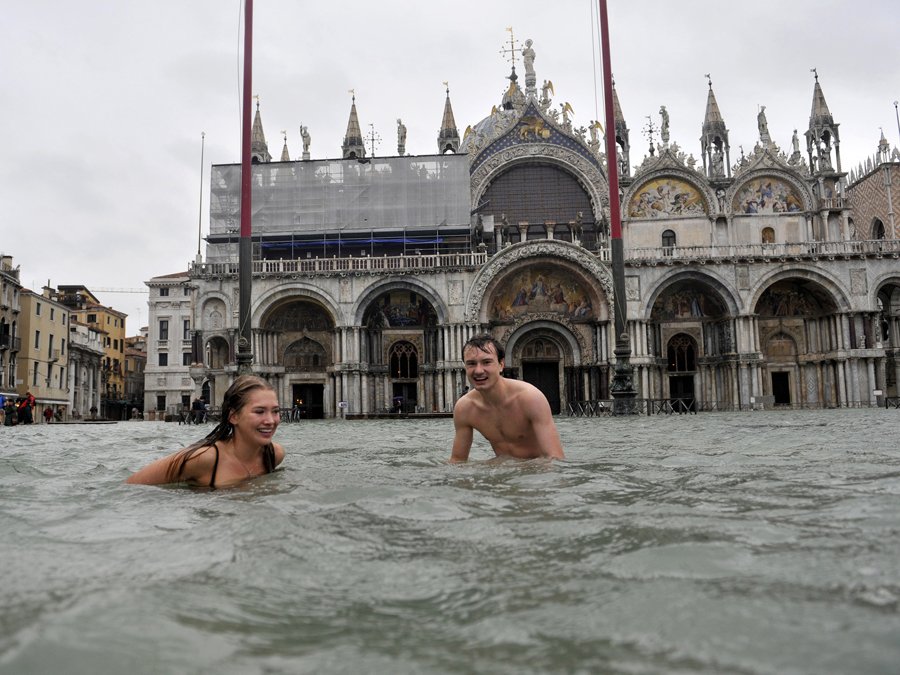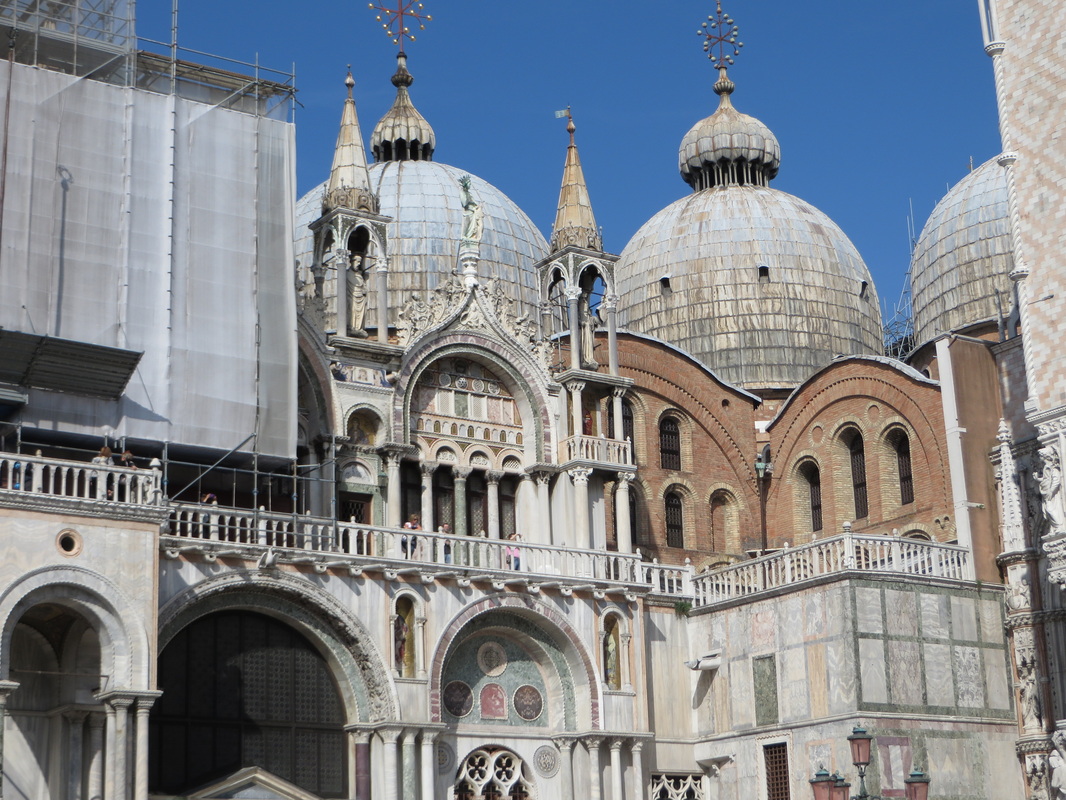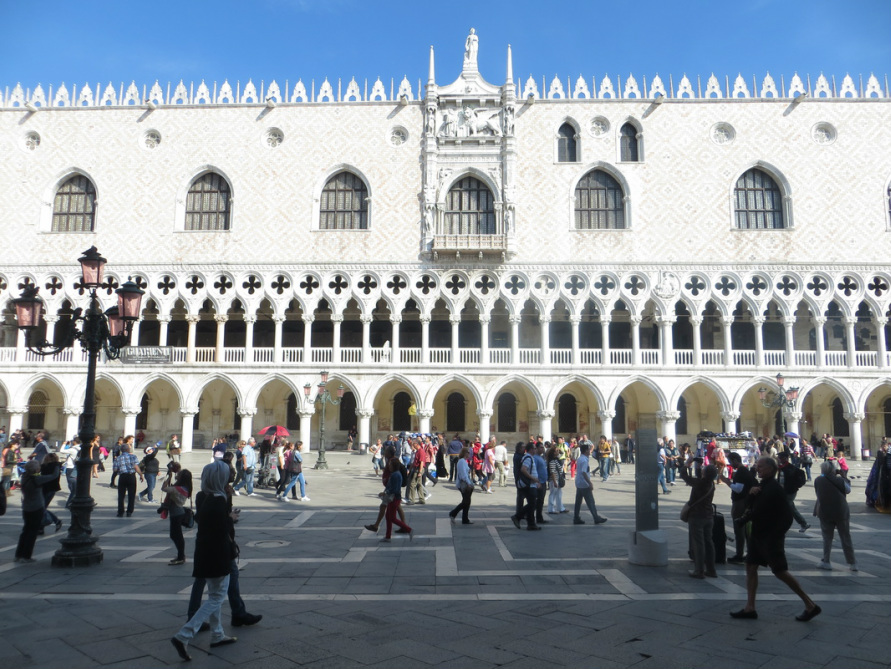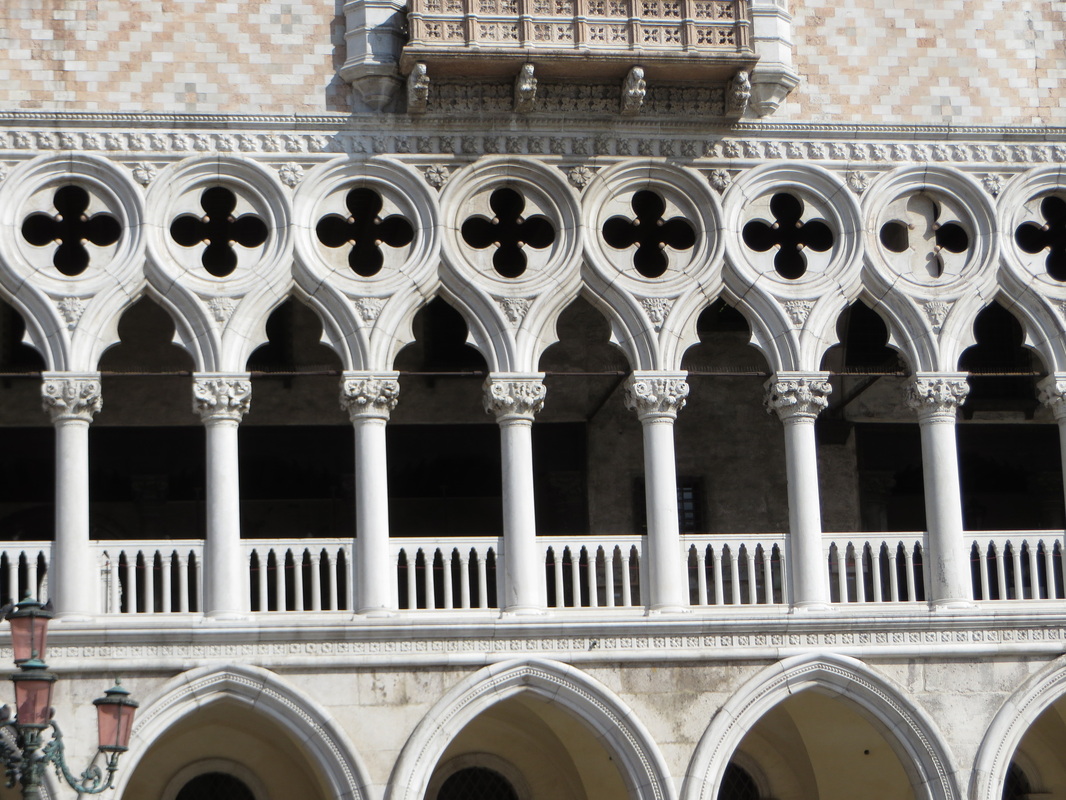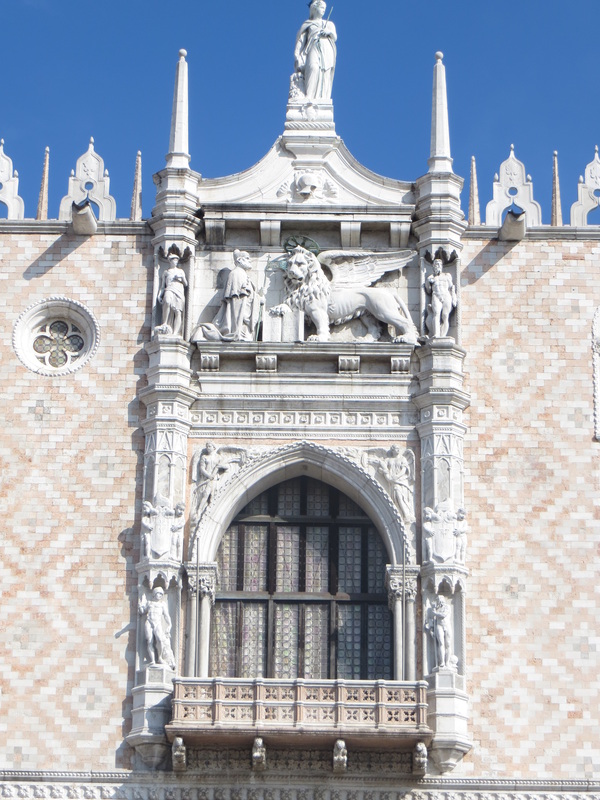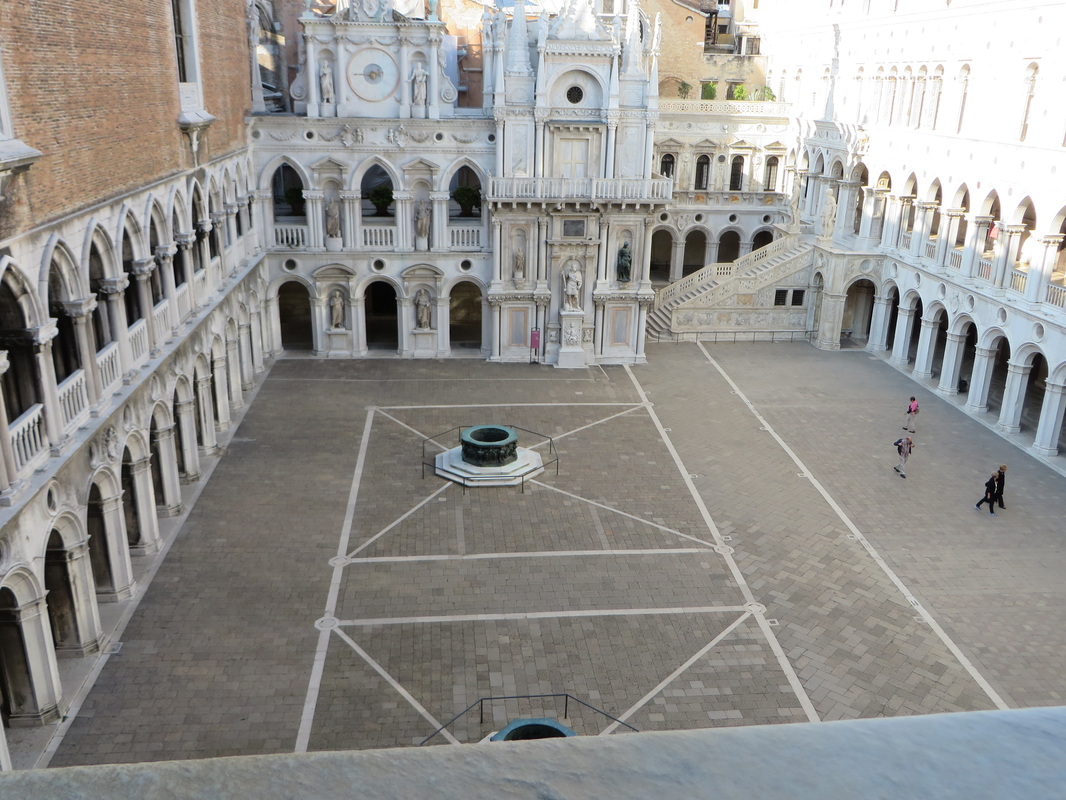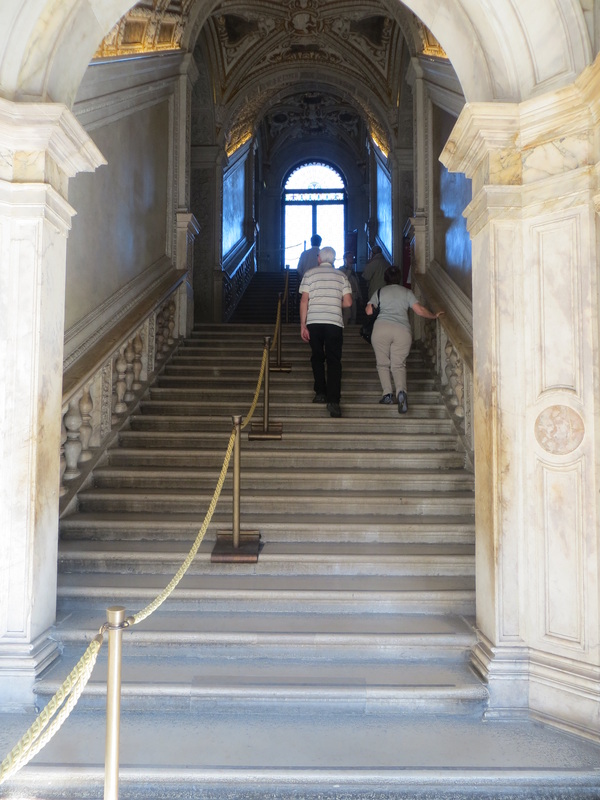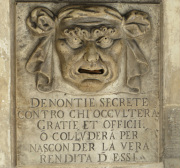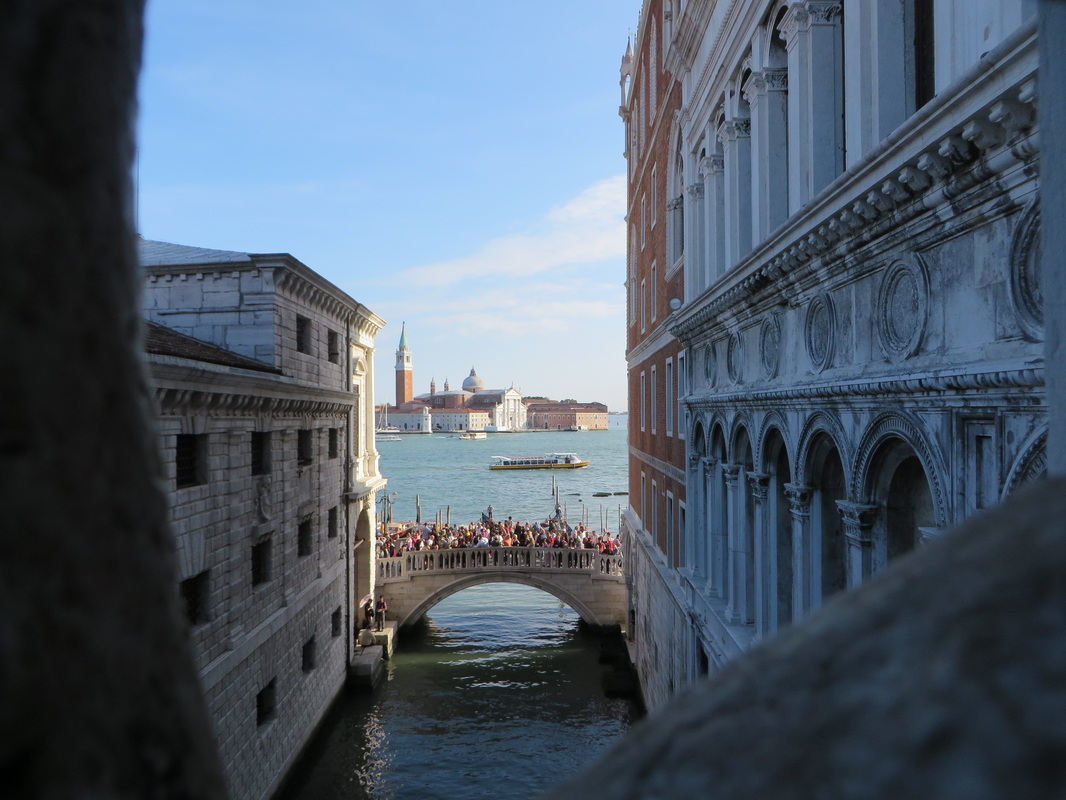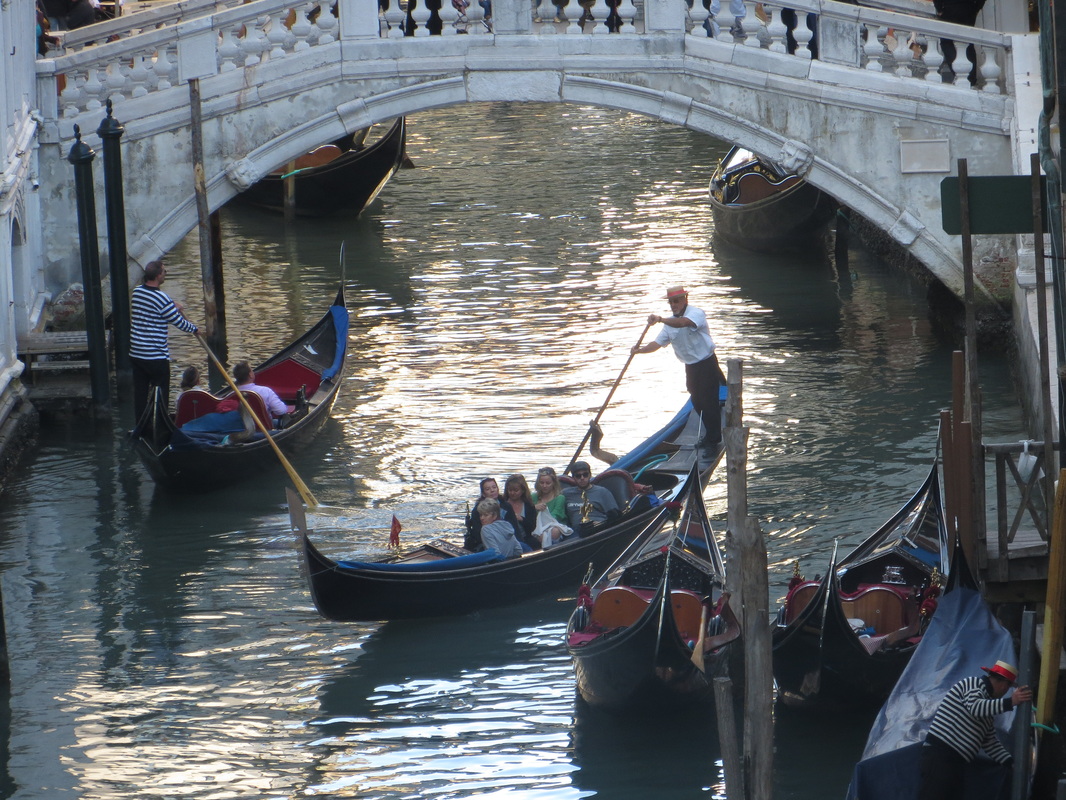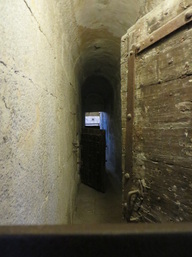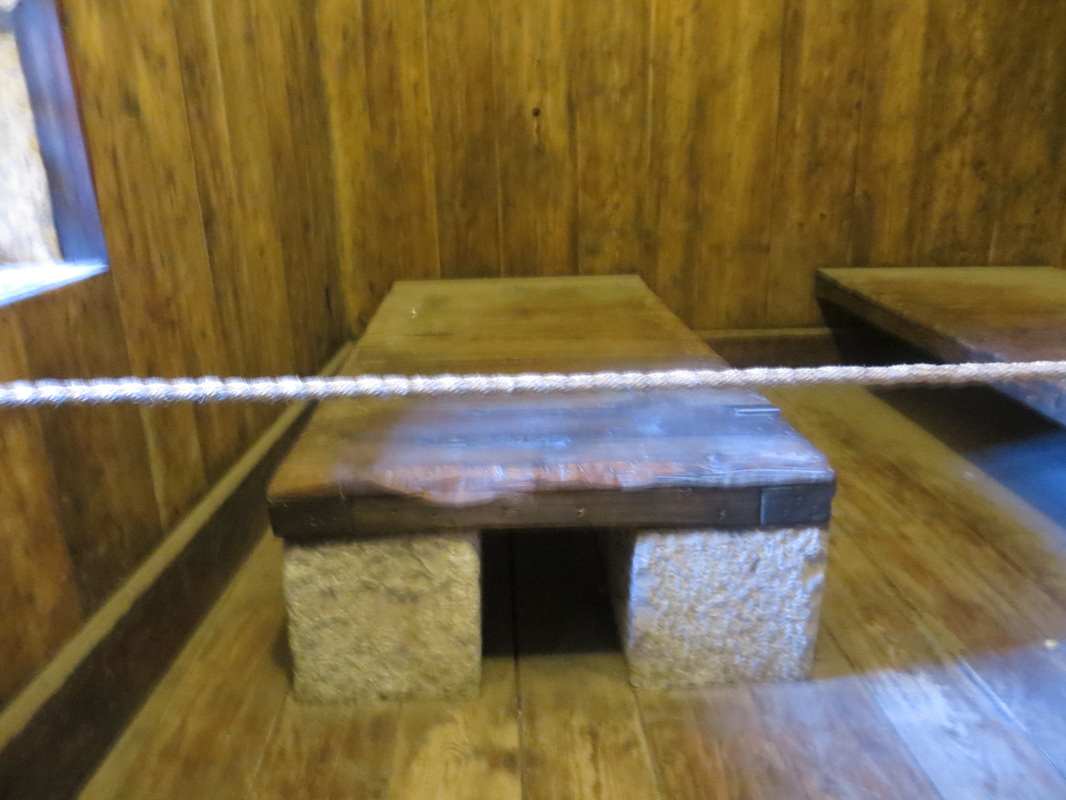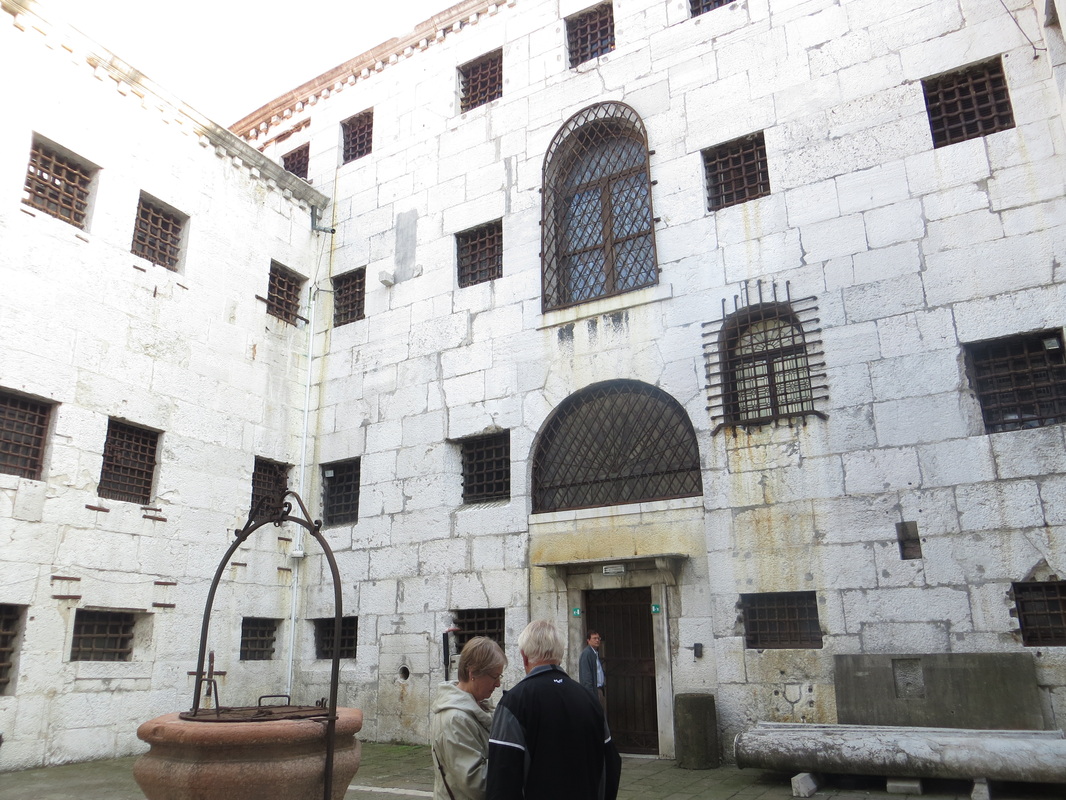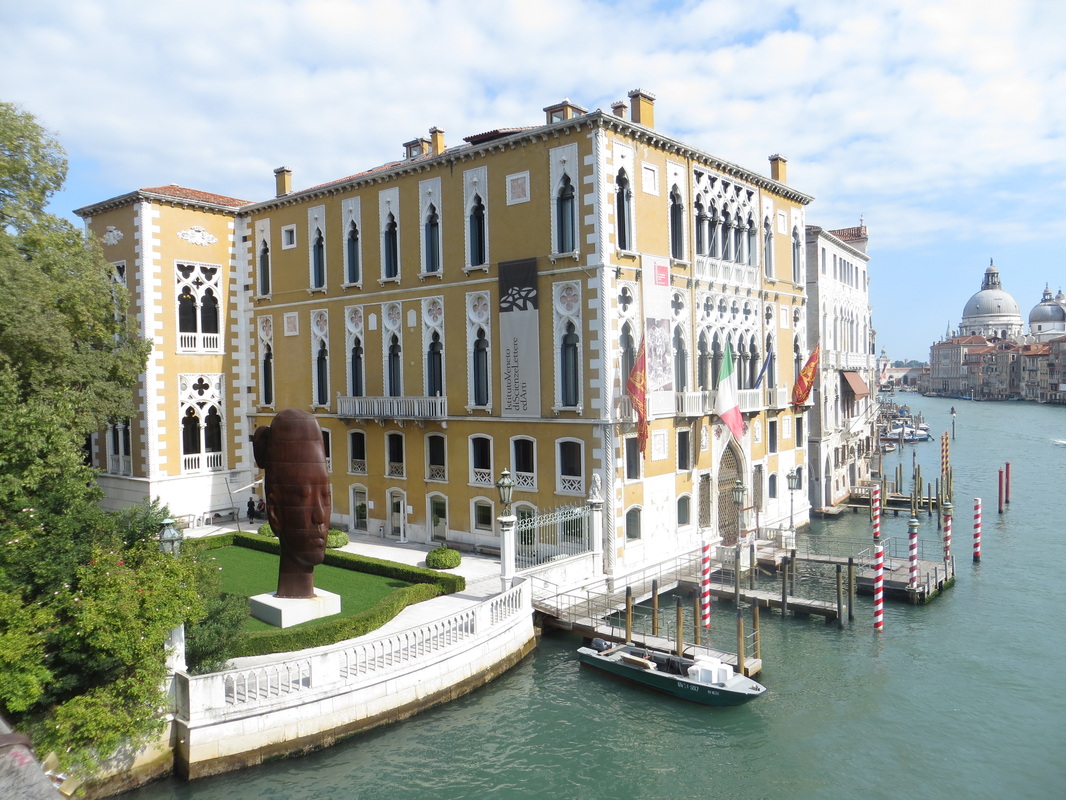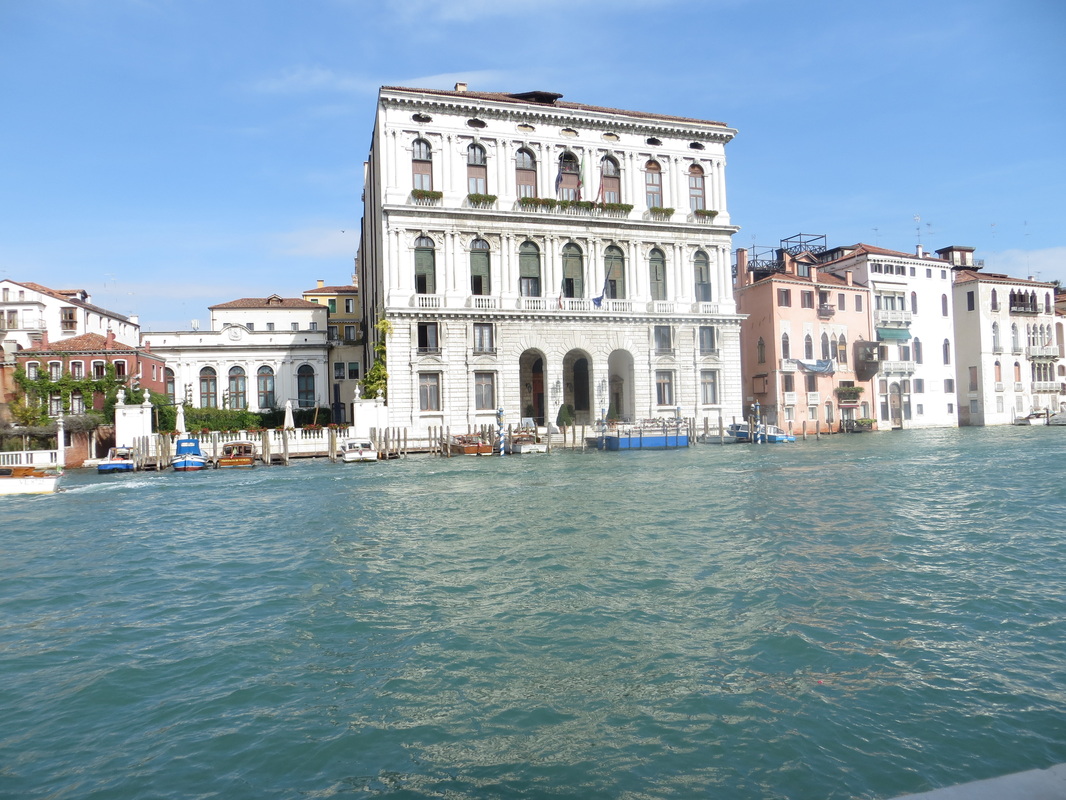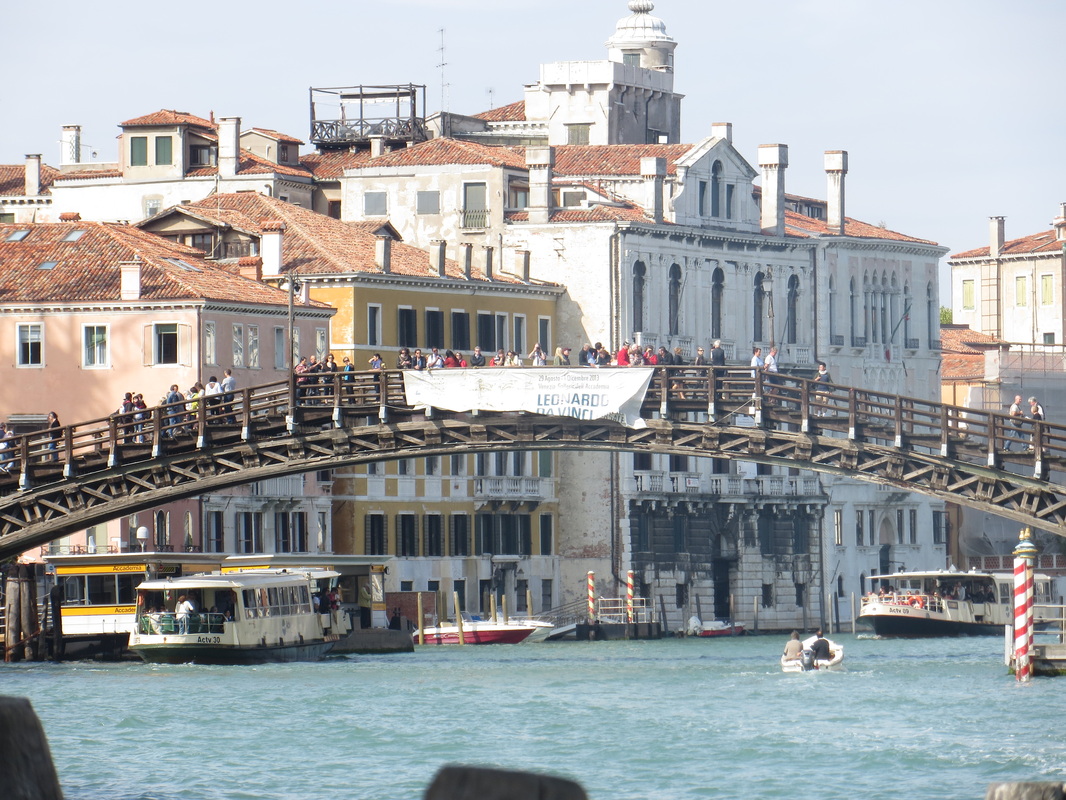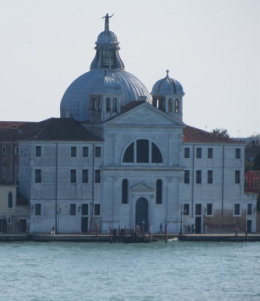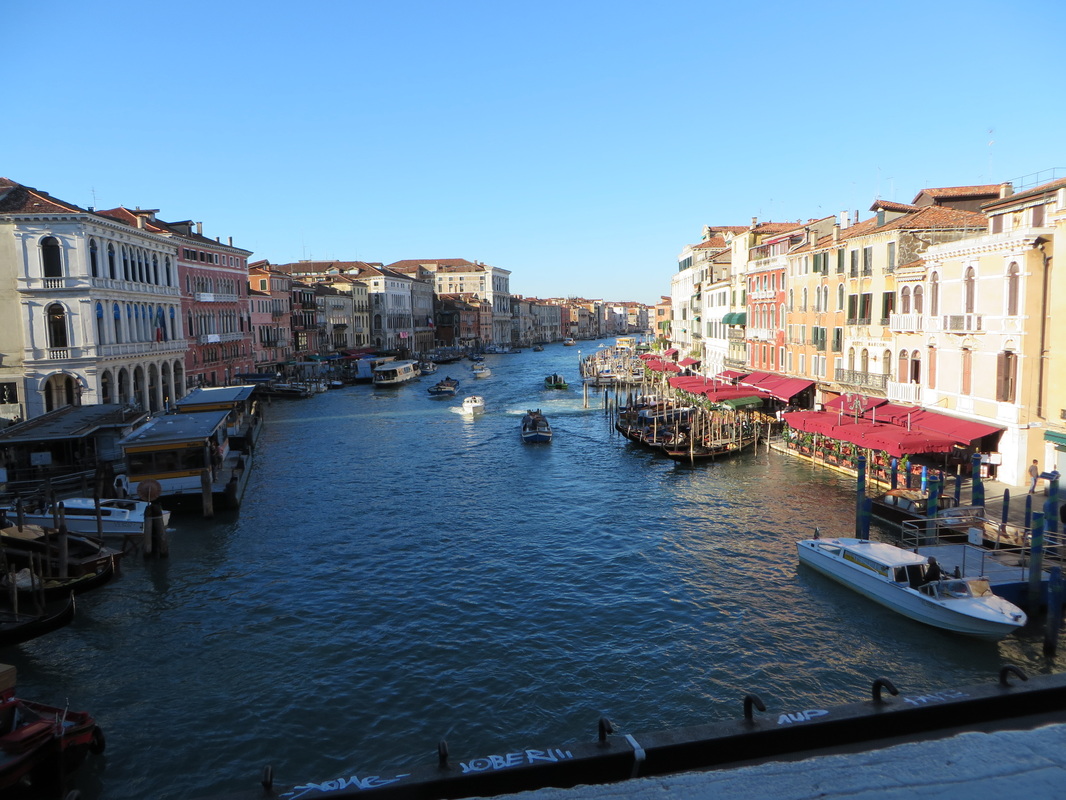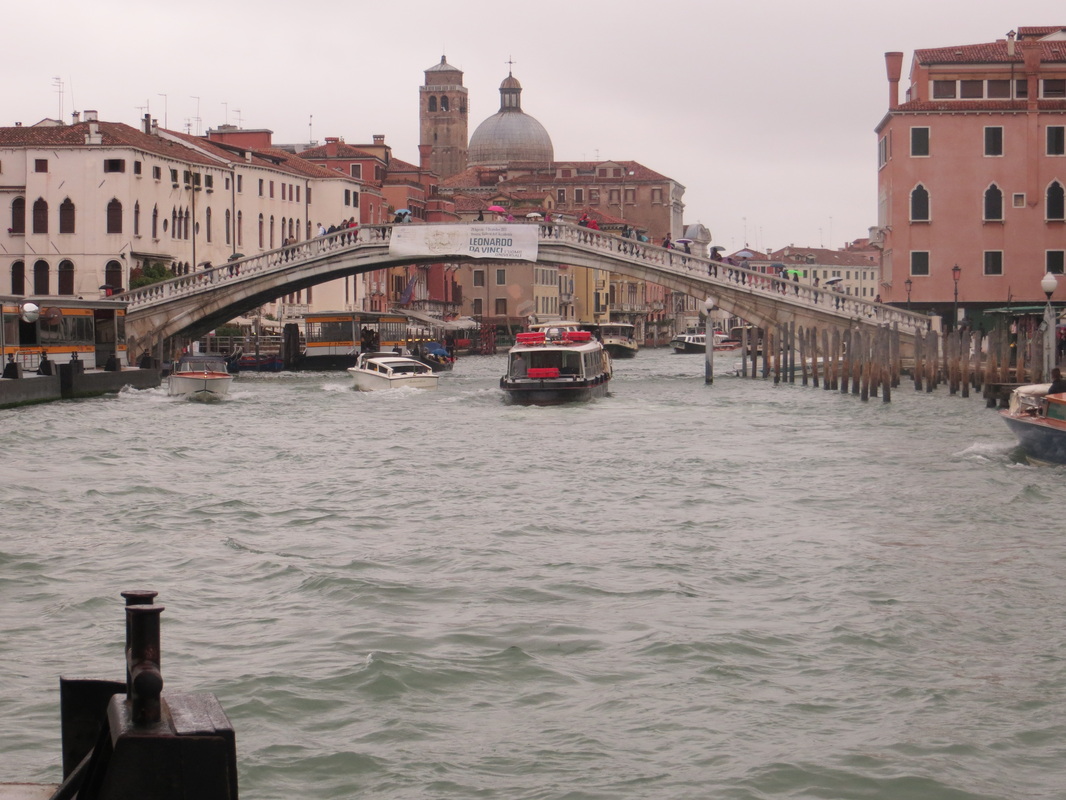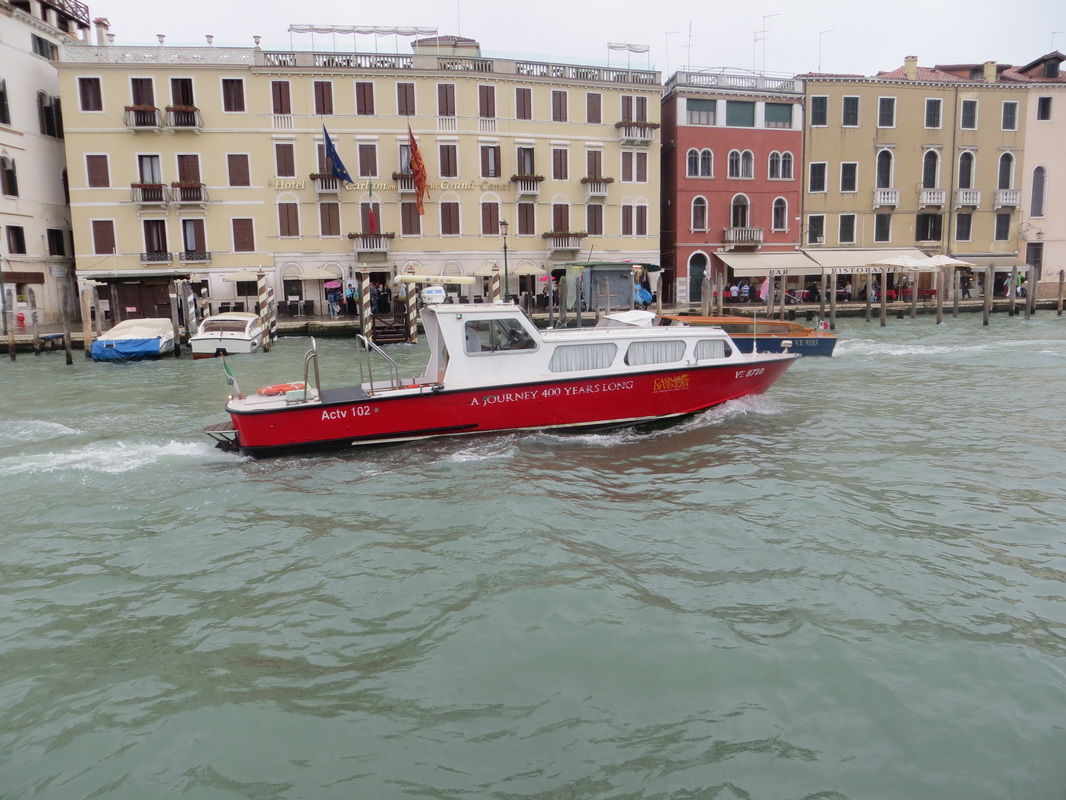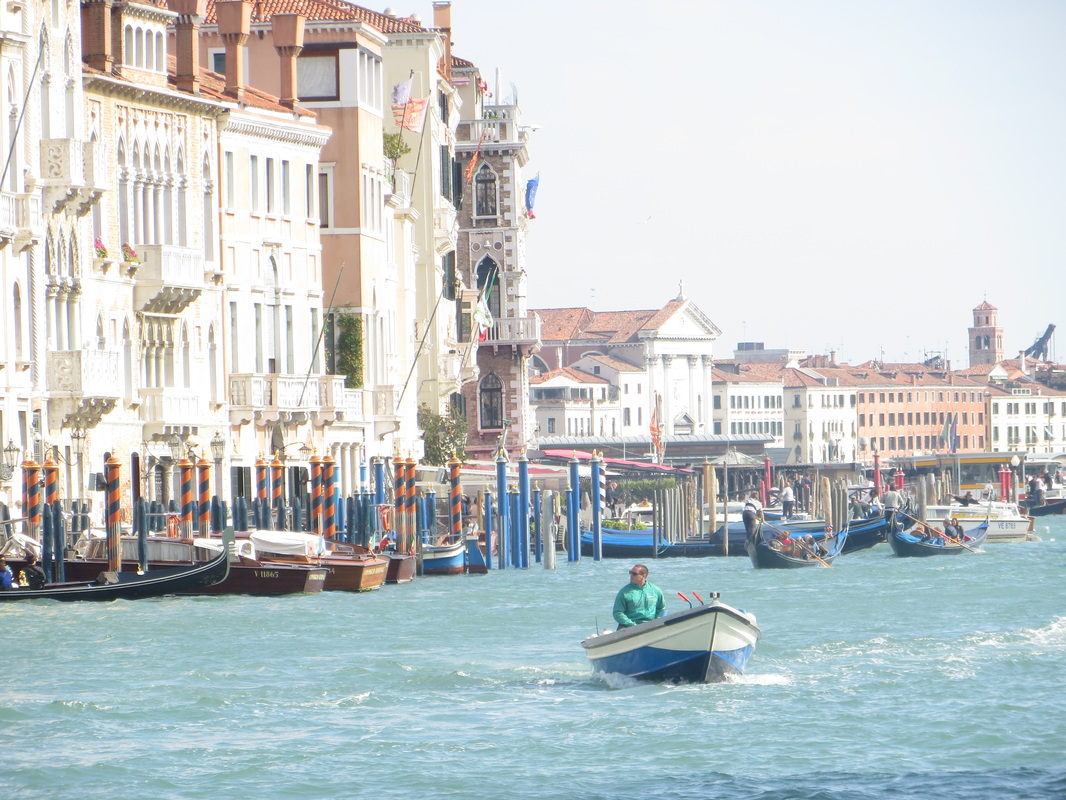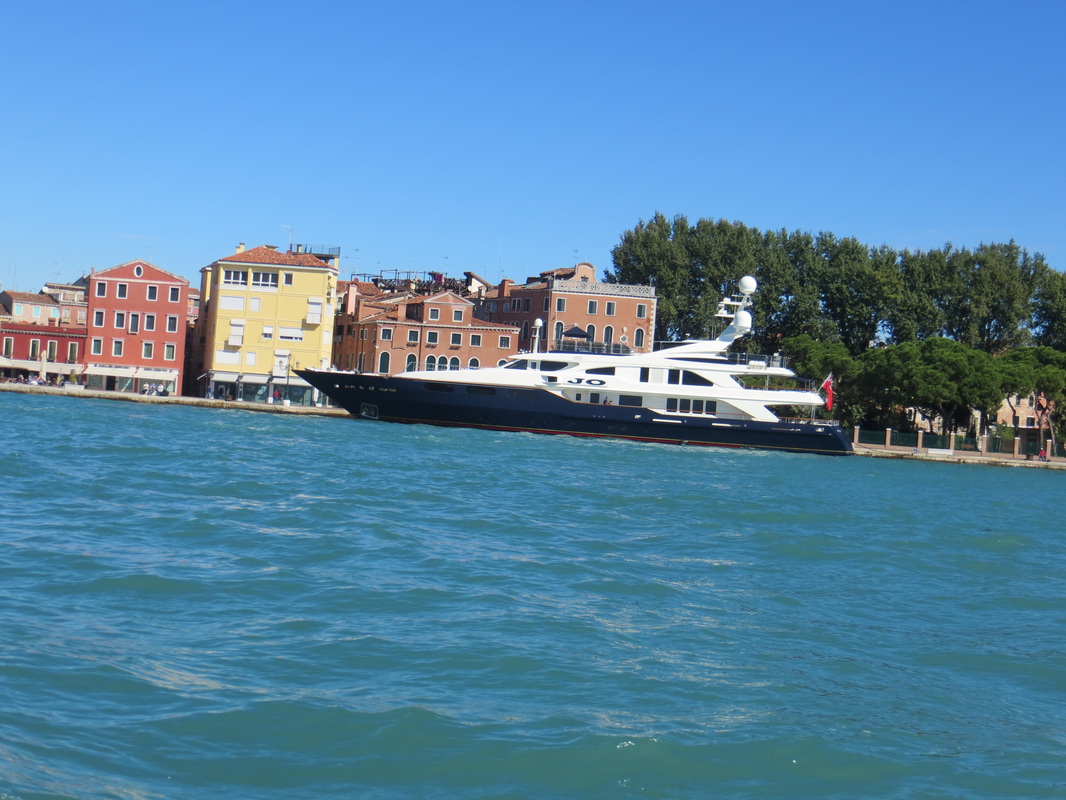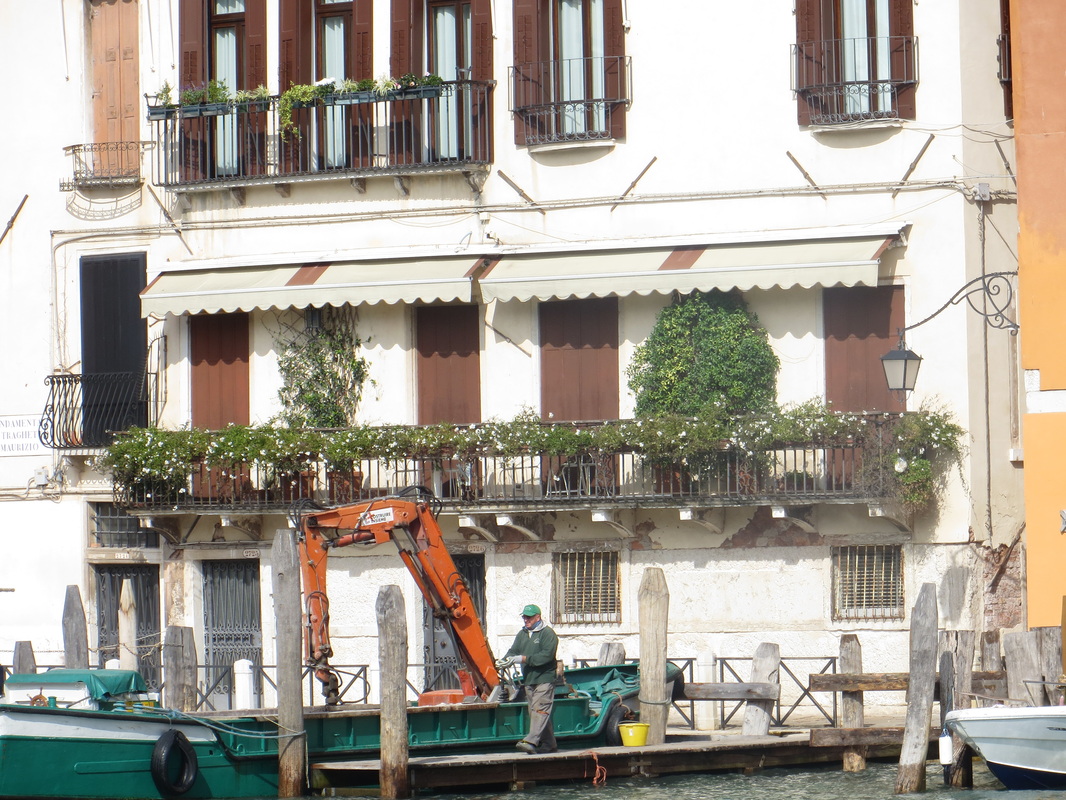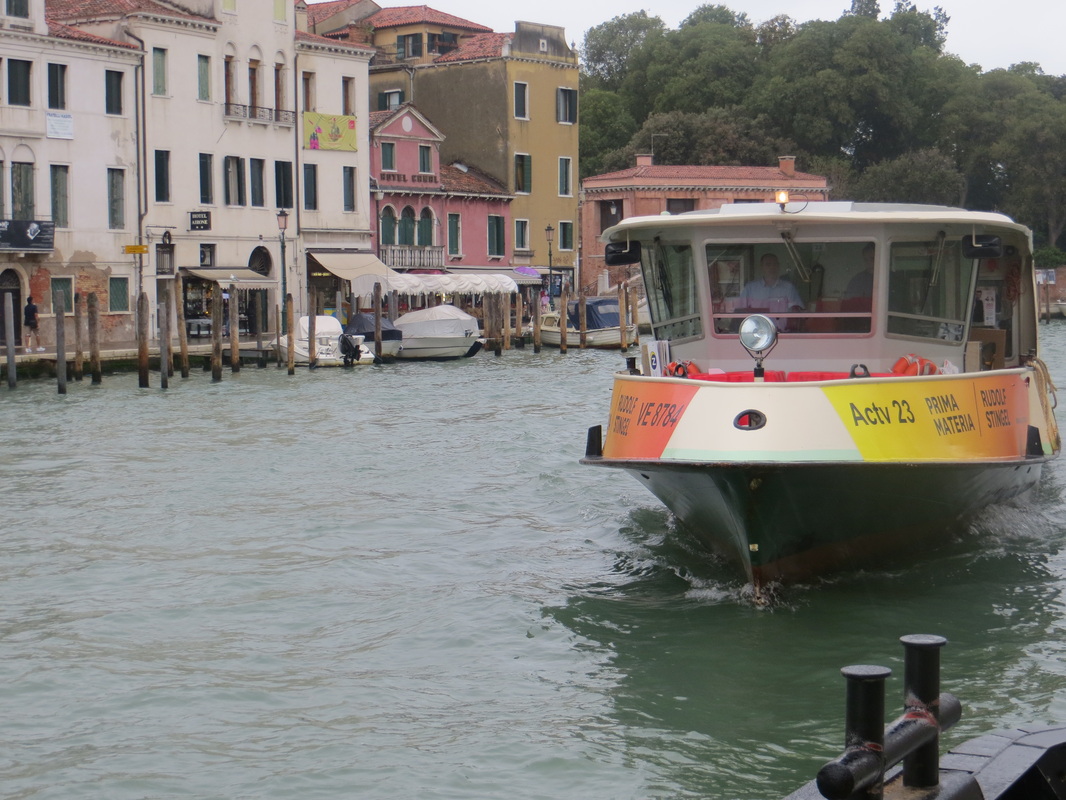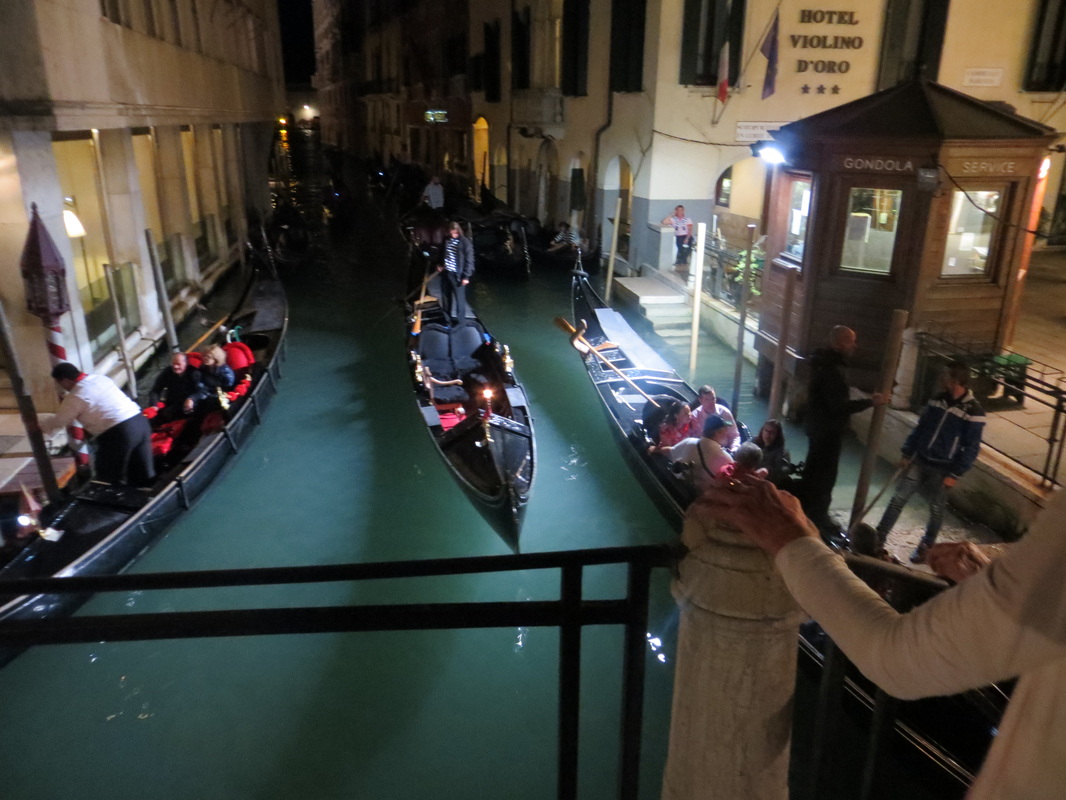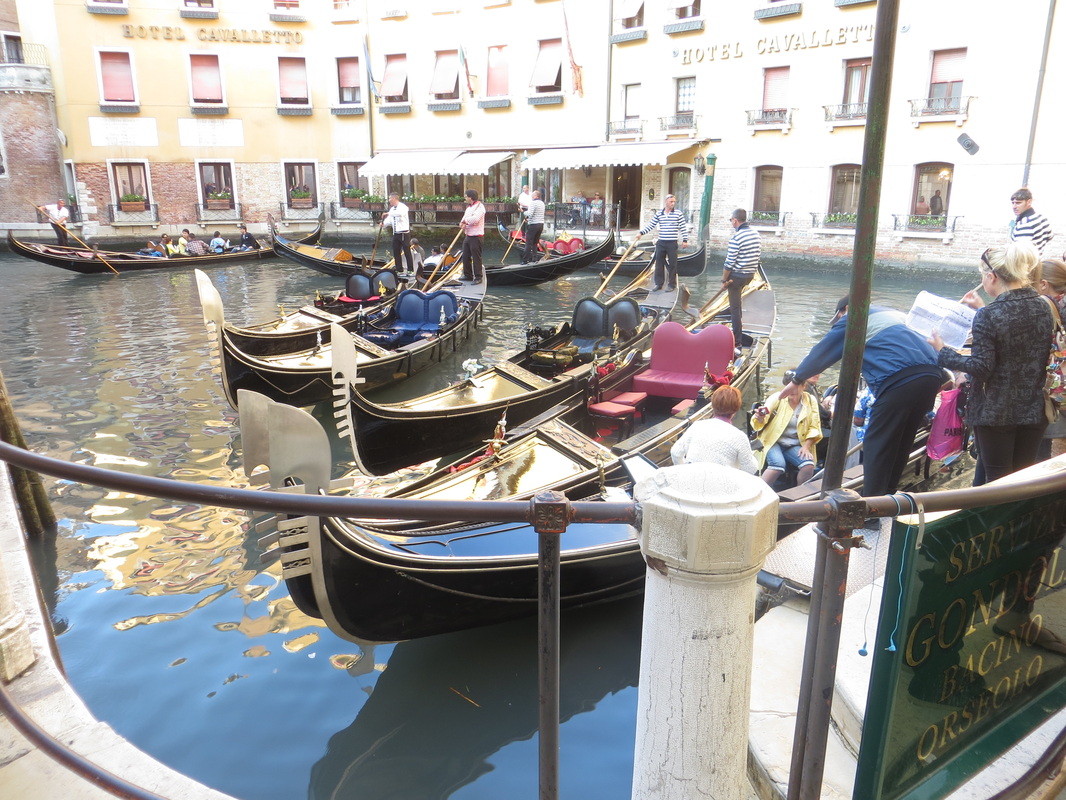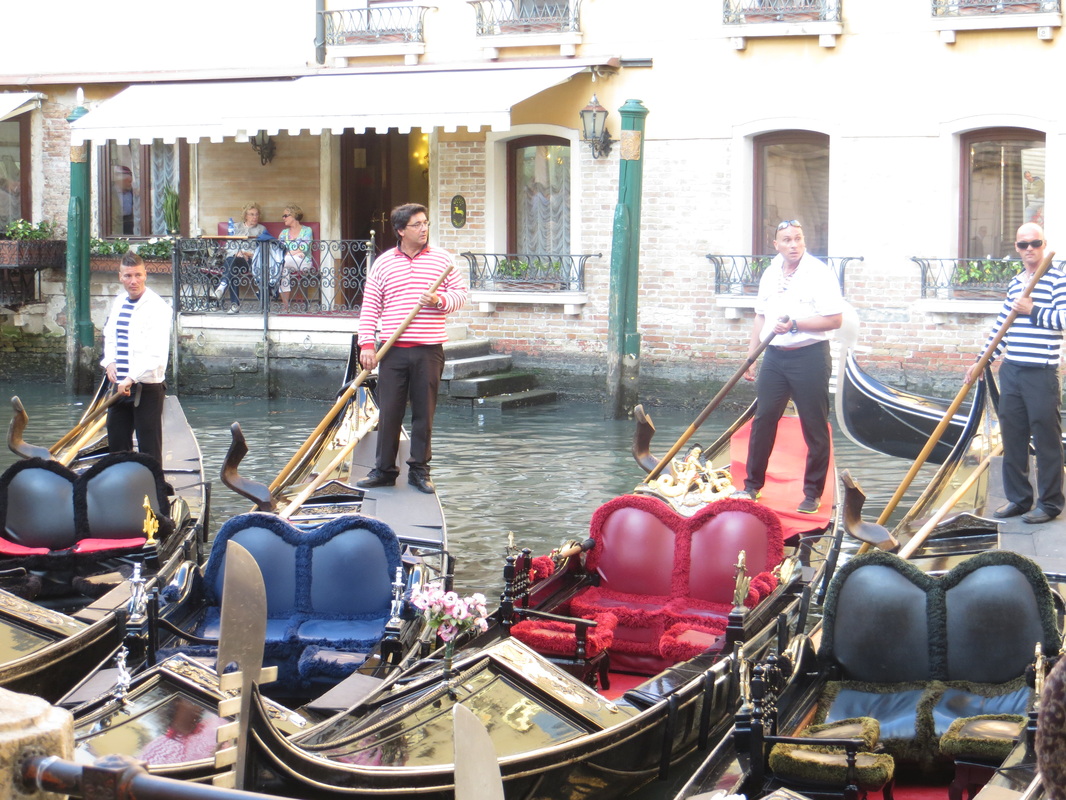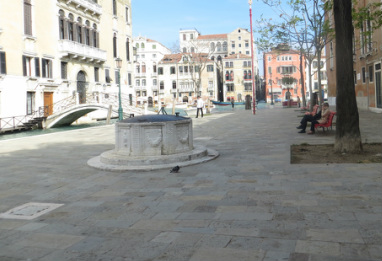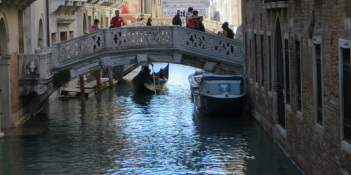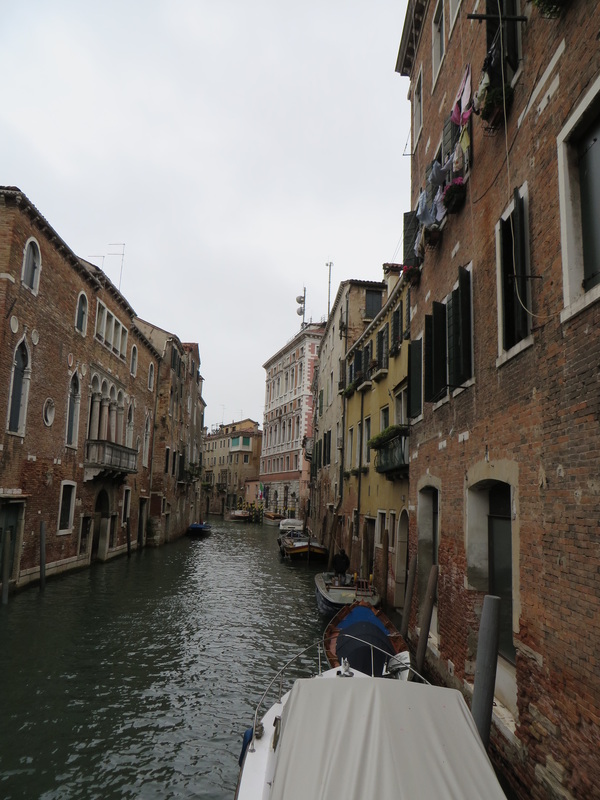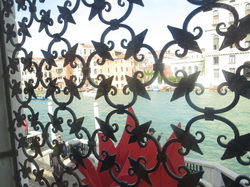The train ride ends at Santa Lucia station right on
the Grand Canal. When you step out of the train station you walk into the watery world of Venice. Wow!
The church across the Canal is San Simeone Piccolo, built in the early years of the 18th century. It is one of the last churches built in Venice. The yellow building to the right is the Ritz Carlton Hotel.
The church across the Canal is San Simeone Piccolo, built in the early years of the 18th century. It is one of the last churches built in Venice. The yellow building to the right is the Ritz Carlton Hotel.
Our hotel, the Pensione Guerrato, is a two minute walk from the vaporetto stop on a "street" that is not even ten feet wide. This is where our Rick Steves tour group will stay. Our pensione is in a very old building. But everything in Venice is in an old building.
The tour starts at 4:00 tomorrow afternoon.
The tour starts at 4:00 tomorrow afternoon.
We are just are just around the corner from the colorful Mercato Rialto, an outdoor produce and fish market that has operated continuously for 700 years.
The Rialto Bridge is a five minute walk away.
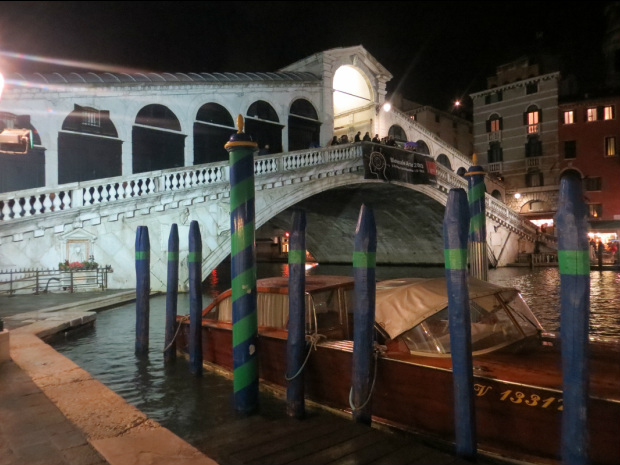
The Rialto Bridge was completed in 1591. It replaced a high maintenance wooden draw bridge built in the 12th century. It’s wide enough to support two lanes of kiosks/shops catering to tourists; so there are 3 lanes of foot traffic - one between the two lanes of shops, and two on the outer edges; and it’s covered. It’s really a sight, and interesting to walk across. After St Mark’s it’s probably the biggest tourist magnet in Venice. The land on either side of it is also one of the lowest spots in the city. The other is Piazzo S. Marco Both are the first places to flood after a big rain. In fact “Rialto” is a contraction of “Rio” (river”) and “alto” (high), so it means “high water”.
Monday September 30 - 4 PM. Our group assembles and our tour begins.
Thanks to fellow traveler Gary Ong for this picture.
|
Our Rick Steves guide is Rozanne Stringer, who is on the faculty at University of Kansas, and has a degree in European Art History with a specialization in the 19th century. And acknowledged gelato fanatico.
After introductions, expectations, questions, and explanations, we are on our “Neighborhood orientation walk,” across the Rialto Bridge and on the way to our "Welcome to Venice" dinner together. |
The food was simple but good - mushroom risotto, gnocchi, and red wine - and we had a chance to get acquainted with our fellow tourists. Rumor has it that Johnny Depp hangs out here.
A Walk to Piazza San Marco
|
Tuesday October 1
Tour groups in Italy must have licensed guides. During our tour we will have five different guides: they are all gracious and provide great insight into the cities and their art. Our first guide is Corrine. She meets us outside our hotel and will lead us on a 3 hour trek through the Cannaregio and San Marco neighborhoods to the Basilica di San Marco. The houses in Venice are built around cortes (courtyards), and when the city was first forming in the 11th and 12th centuries a well was dug in the center allowing easy access to water. The wells have since been sealed, but some structural elements often remain. Here Corrine explains that to us, and also says that the house in the corner may or may not be (its only a legend) the home of Marco Polo. |
|
Santa Maria dei Miracoli
late 15th century |
This may be the prettiest church we saw. It’s also called the “marble church." The organization "Save Venice" restored the church in the 1990s. The exterior marble was so filled with salt that it was about to burst. The restoration was supposed to take two years and cost a million dollars; it turned out to be 10 years and 4 million. This is said to be the work shop of the Bellini family - Renaissance painters of the 15th and early 16th centuries. Titian and Giorgione were both apprentices in the Bellini workshop.
|
|
The church of San Giovanni e Paulo is under renovation.
This is one of the largest churches in Venice. Since the 15th century the funeral services of all Venice's doges were held here; and twenty-five doges are buried in the church. Below is the Campo next to the church. A campo (usually called a piazza in other Italian cities) is a gathering place, often adjacent to a church or other public building. |
|
This is a fairly typical street, which connects two cortes.
|
This hotel, a 5 minute walk from San Marco has rooms at $270 a night.
|
The Bridge of Sighs (Ponte dei Sospiri). So called because it was the last view of Venice that convicts saw before their imprisonment. Later we'll see it from the prisoners’ vantage.
|
Piazza San Marco
|
Napoleon called St Mark’s Square “the drawing room of Europe.” The square is the heart of Venice, and the only square called a Piazza; all others are “campi.” It is almost two football fields long from St Mark’s Church on the east to the Correr Museum on the west. It is prone to flooding and was partially flooded at the east end when were there. There had been steady rains for the past two days. |
|
Flooding of the Piazza is so frequent that platforms are standing by so tourists can enter St Mark's Basilica. This is our group entering. A day later the piazza was dry and the platforms were put away.
|
In November 2012, 75% of the city was under water. Water levels reached 5 feet, the 6th highest in over 140 years.
|
The Basilica di San Marco dates to the 11th century. The present church replaces a smaller chapel built in the 9th century. The distinctive eastern architectural style (note the domes) reflects Venice’s connections with the Byzantine Empire. The Venetian Republic expanded eastward along the Adriatic Sea into what is today Slovenia and Croatia. It also provided protection from the eastward expansion of the Holy Roman Empire.
Venice was a very rich and powerful republic ruled by businessmen, not church figures, which was very unusual in Europe.
Venice was a very rich and powerful republic ruled by businessmen, not church figures, which was very unusual in Europe.
The Doge's Palace - Palazzo Ducale
The Republic of Venice was a dominant military, economic and trading power from the 7th century until it fell to Napoleon in 1797. The Doge was the elected head of state, beginning in the early years of the 8th century when Venice was a province of the Byzantine Empire. A measure of the Doge’s power and status in Venice is that until the 18th century St Mark’s Basilica was considered the Doge’s Chapel and a special pulpit was built for him to lead prayers and make announcements.
The present palace dates from the latter 12th century. Construction of what we see today began in mid 14th century. Several fires resulted in large renovations and additions. In the late 19th century the Italian government made major renovations and in 1923 it gave management of the Palace to Venice to be run as a museum.
The exterior of the Palace is a mixture of Byzantine and Venetian influences
The exterior of the Palace is a mixture of Byzantine and Venetian influences
And this is the inside of the prison - connected to the Doge's Palace by the Bridge of Sighs.
On the Water
The Grand Canal is Venice's Main Street. It is two miles long, 150 feet wide and 15 feet deep. There are two smaller canals and 45 smaller “rii” (rivers) that flow into the Grand Canal. Plying the canals are vaporetti (water taxis) police and government boats, work boats, personal transportation and fishing boats, small luxury boats and the romantic and colorful gondole. Luxurious pallazzi line the Grand Canal; smaller homes and shopping areas line the smaller canals and rivers. Real estate on the Grand Canal can cost as much as $100,000 a square foot. Flooding and rising water levels have led to a polyglot of elegance and decay.
The smaller side canals are more tranquil.
Venice's Art

Seeing Venice's art and architecture is a wonderful experience. People of all types have been doing it for hundreds of years. Trying to bring home what you have seen is very frustrating. "NO PHOTOGRAPHY ALLOWED" is a constant inside most galleries and museums. So pictures of great art will be limited here to what was allowed.
|
Our group visited the Accademia Gallerie (Gallerie dell'Accademia) on our second day in Venice. It displays Venetian art from the Middle Ages through the 18th century. Our guides, Laura and Corrine, gave us a marvelous tour and lecture. Using the paintings in the Accademia they showed the development of art from the start of the 14th century to the end of the 15th, the high point of the Renaissance in Florence. Some of their points: icons (thought to have miraculous powers) were no longer emphasized in religious paintings; saints were less likely to be portrayed with halos; paintings were given shadows and depth, and colors were subdued - all placing saints more in the real world than in a far off heaven. Some of the painters we saw: Ghirlandaio, Giorgione (The Tempest), Mantegna, Tintoretto, Titian, and Veronese. There was special exhibit of Leonardo’s sketches and notebooks for several of his works. Here is the Wikipedia link to the Accademia:
http://en.wikipedia.org/wiki/Gallerie_dell%27Accademia |
On our own we saw more of Venice's art: The Peggy Guggenheim Collection, and the Frari and San Polo churches.
* * * * * * *
On the day before our tour began we visited two churches near our hotel. It was our first challenge, to navigate the rat's maze that is Venice's street system. But we found the churches and passed "Finding Your Way Around Venice 101."
We also enjoyed the opportunity to see art "in situ," pieces displayed where they were intended. We were fairly alone with the art and could view it at our own pace.
We also enjoyed the opportunity to see art "in situ," pieces displayed where they were intended. We were fairly alone with the art and could view it at our own pace.
|
San Polo (Paul) Church is small but one of the oldest churches in Venice, built in the 15th century on the site of another church built in the 9th century).
In the back of the church is a painting of the Last Supper by Jocopo Robusti ditto Tintoretto done in 1568. Tintoretto was nicknamed "Il Furioso" for the phenomenal energy in his work; characterized by muscular figures, dramatic gestures, and bold use of perspective. This Last Supper is very different from what we usually see representing the Last Supper. In a side chapel is a series of paintings depicting the Stations of Cross. Each painting is about 4 feet high. The one you see here is "Jesus is Nailed to the Cross." The stations are by Giandomenico Tiepolo (18th century). |
Click on the picture for the slide show
|

The second church was Sta Maria Gloriosa dei Frari, usually called Il Frari, which means Friars. It was built by the Franciscans in the late 15th century, and is one of the more important churches in Venice. It has works by Donatello, Giovanni Bellini, and Titian, and a huge monument where Titian is buried. No photography is allowed inside the church, and the outside was covered with construction netting so pictures of that don’t show much. But here is a Wikipedia link:
http://en.wikipedia.org/wiki/Santa_Maria_Gloriosa_dei_Frari
This is a beautiful church, probably our favorite in Venice. Titian’s Assumption of the Virgin is behind the altar and dominates the interior. We spent an hour just sitting in the pews and studying the Assumption and other works by Bellini and Donatello.
http://en.wikipedia.org/wiki/Santa_Maria_Gloriosa_dei_Frari
This is a beautiful church, probably our favorite in Venice. Titian’s Assumption of the Virgin is behind the altar and dominates the interior. We spent an hour just sitting in the pews and studying the Assumption and other works by Bellini and Donatello.
* * * * * * *
|
If you want to see more of Venice, click on one these buttons.
|
